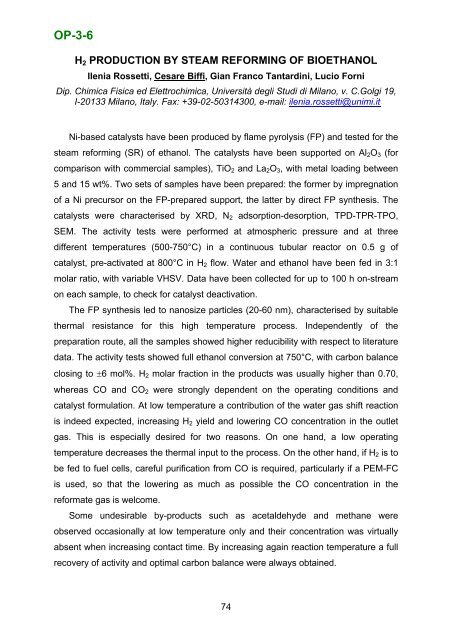OP-3-6H 2 PRODUCTION BY STEAM REFORMING OF BIOETHANOLIlenia Rossetti, Cesare Biffi, Gian Franco Tantardini, Lucio ForniDip. Chimica Fisica ed Elettrochimica, Università degli Studi di Milano, v. C.Golgi 19,I-20133 Milano, Italy. Fax: +39-02-50314300, e-mail: ilenia.rossetti@unimi.itNi-based catalysts have been produced by flame pyrolysis (FP) and tested for thesteam reforming (SR) <strong>of</strong> ethanol. The catalysts have been supported on Al 2 O 3 (forcomparison with commercial samples), TiO 2 and La 2 O 3 , with metal loading between5 and 15 wt%. Two sets <strong>of</strong> samples have been prepared: the former by impregnation<strong>of</strong> a Ni precursor on the FP-prepared support, the latter by direct FP synthesis. Thecatalysts were characterised by XRD, N 2 adsorption-desorption, TPD-TPR-TPO,SEM. The activity tests were performed at atmospheric pressure and at threedifferent temperatures (500-750°C) in a continuous tubular reactor on 0.5 g <strong>of</strong>catalyst, pre-activated at 800°C in H 2 flow. Water and ethanol have been fed in 3:1molar ratio, with variable VHSV. Data have been collected for up to 100 h on-streamon each sample, to check for catalyst deactivation.The FP synthesis led to nanosize particles (20-60 nm), characterised by suitablethermal resistance for this high temperature process. Independently <strong>of</strong> thepreparation route, all the samples showed higher reducibility with respect to literaturedata. The activity tests showed full ethanol conversion at 750°C, with carbon balanceclosing to ±6 mol%. H 2 molar fraction in the products was usually higher than 0.70,whereas CO and CO 2 were strongly dependent on the operating conditions andcatalyst formulation. At low temperature a contribution <strong>of</strong> the water gas shift reactionis indeed expected, increasing H 2 yield and lowering CO concentration in the outletgas. This is especially desired for two reasons. On one hand, a low operatingtemperature decreases the thermal input to the process. On the other hand, if H 2 is tobe fed to fuel cells, careful purification from CO is required, particularly if a PEM-FCis used, so that the lowering as much as possible the CO concentration in thereformate gas is welcome.Some undesirable by-products such as acetaldehyde and methane wereobserved occasionally at low temperature only and their concentration was virtuallyabsent when increasing contact time. By increasing again reaction temperature a fullrecovery <strong>of</strong> activity and optimal carbon balance were always obtained.74
OP-3-7HYDROGEN AND SYNGAS PRODUCTION BY ETHANOL STEAMREFORMING OVER COMPOSITE CATALYSTS COMPRISED OFNi/YSZ AND COMPLEX OXIDESMezentseva N. 1 , Alikina G. 1 , Krieger T. 1 , Ishchenko A. 1 ,Smorygo O. 2 , Sadykov V. 1,31 <strong>Boreskov</strong> <strong>Institute</strong> <strong>of</strong> <strong>Catalysis</strong> <strong>SB</strong> <strong>RAS</strong>, <strong>Novosibirsk</strong>, <strong>Russia</strong>, mnv@catalysis.ru2 Powder Metallurgy <strong>Institute</strong>, Minsk, Belarus3 <strong>Novosibirsk</strong> State University, <strong>Novosibirsk</strong>, <strong>Russia</strong>Transformation <strong>of</strong> bi<strong>of</strong>uels into syngas or hydrogen via steam reforming is nowconsidered as one <strong>of</strong> the most important task <strong>of</strong> catalysis in the energy-related fields.However, due to a high reactivity <strong>of</strong> oxygenates a heavy coking is observed leadingto the catalyst deactivation. To deal with this phenomenon, active componentscomprised <strong>of</strong> complex oxides with a high lattice oxygen mobility (favors efficientgasification <strong>of</strong> coke precursors) promoted by precious metals (responsible foroxygenates activation) are suggested [1]. Ethanol is one <strong>of</strong> the major componentswhich are present in bi<strong>of</strong>uels and hence, ethanol steam reforming (ESR) is a suitablereaction for the development <strong>of</strong> an efficient bio-oil processing via SR.In the present work, the nanocomposite catalysts based on Ni/YSZ (20-90wt.%)cermets co-promoted with SmPrCeZrO or LaPrMnCrO oxides (80-10wt.%) and Pt orRu were synthesized by modified Pechini method. Samples were characterized byBET, XRD, TEM with EDX, C 2 H 5 OH (1% in He) TPR and their subsequent TPOx byH 2 O (1% in He). The catalytic properties <strong>of</strong> nanocomposite catalysts were studied inthe SR <strong>of</strong> ethanol in diluted and realistic feeds at short contact time.Applied preparation procedures result in pronounced interaction betweennanocrystalline active components including decoration <strong>of</strong> NiO/Ni particles by oxidicfragments, epitaxial intergrowth between particles <strong>of</strong> different phases, incorporation<strong>of</strong> Ni, Pt and Ru cations into perovskite or fluorite particles directly revealed by EDXand reflected in variation <strong>of</strong> lattice spacings and particle sizes. All studied samplesdemonstrate a high and stable performance in the steam reforming <strong>of</strong> ethanol in theintermediate temperature range (500-600 o C). For samples with the low (20%) Ni/YSZcontent promotion by Pt or Ru does not improve performance determined mainly bythe oxygen mobility in fluorite or perovskite oxides and accessible Ni surfacedecorated by oxidic species. Performance <strong>of</strong> best compositions supported as porousstrongly adhering layers on cr<strong>of</strong>er/fechraloy nonporous/porous monolithic substrateswas demonstrated to be also high and stable in ESR ensuring reformate compositionclose to equilibrium.[1]. J.P.Breen, R. Burch, H.M. Coleman, Appl.Cat. B 39 (2002) 65.Acknowledgements: This work is supported by Integration Project 57 <strong>of</strong> <strong>SB</strong> <strong>RAS</strong> andProject 57 <strong>of</strong> Presidium <strong>RAS</strong>.75
















